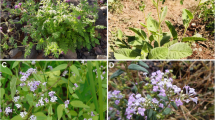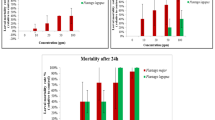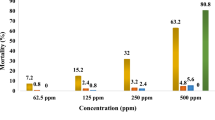Abstract
In a search for natural products that could be used to control the vectors of tropical diseases, extracts of medicinal plants Plumbago zeylanica and Cestrum nocturnum have been tested for larvicidal activity against second, third, and fourth instar larvae of Aedes aegypti. The LC50 values of all the extracts in different solvents of both the plants were less than 50 ppm (15.40–38.50 ppm) against all tested larval instars. Plant extracts also affected the life cycle of A. aegypti by inhibition of pupal development and adult emergence with increasing concentrations. The larvicidal stability of the extracts at five constant temperatures (19°C, 22°C, 25°C, 28°C, and 31°C) evaluated against fourth instar larvae revealed that toxicity of both plant extracts increases with increase in temperature. Toxicity studies carried out against fish species Poecilia reticulata, the most common nontarget organism in the habitats of A. aegypti, showed almost nil to meager toxicity at LC50 and LC90 doses of the plant extracts. The qualitative analysis of crude extracts of P. Zeylanica and C. nocturnum revealed the presence of bioactive phytochemicals with predominance of plumbagin in P. zeylanica and saponins in C. nocturnum. Partially purified plumbagin from P. zeylanica and saponins from C. nocturnum were obtained, and their presence was confirmed by thin-layer chromatography and biochemical tests. The bioassay experiment of partially purified secondary metabolites showed potent mosquito larvicidal activity against the fourth instar larval form. Therefore, this study explored the safer and effective potential of plant extracts against vector responsible for diseases of public health importance.
Similar content being viewed by others
References
Abbott WS (1925) A method of computing the effectiveness of an insecticide. J Eco Entomol 18:265–266
Ali A, Nayar JK, Xue RD (1995) Comparative toxicity of selected larvicides and insect growth regulators to a Florida laboratory, population of Aedes albopictus. J Am Mosq Control Assoc 11(1):72–76
Amer A, Mehlhorn H (2006a) Larvicidal effects of various essential oils against Aedes, Anopheles, and Culex larvae (Diptera, Culicidae). Parasitol Res 99:466–472
Amer A, Mehlhorn H (2006b) Persistency of larvicidal effects of plant oil extracts under different storage conditions. Parasitol Res 99:473–477
Amer A, Mehlhorn H (2006c) Repellency effect of forty-one essential oils against Aedes, Anopheles and Culex mosquitoes. Parasitol Res 99:478–490
Bagavan A, Rahuman AA, Kamaraj C, Geetha (2008) Larvicidal activity of saponin from Achyranthes aspera against Aedes aegypti and Culex quinquefasciatus (Diptera: Culicidae). Parasitol Res 103:223–229
Bouchbaver G, Jirovetz L, Koul VK (1995) Volatiles of the absolute of Cestrum nocturnum L. J Essent Oil Res 7:5–9
Chapagain BP, Wiesman Z, TsrorLahkim L (2007) In-vitro study of antifungal activity of saponin-rich extracts against prevalent phytopathogenic fungi. Ind Crops Prod 26:109–115
Chapagain BP, Saharan V, Wiesman Z (2008) Larvicidal activity of saponins from Balanites aegyptiaca callus against Aedes aegypti mosquito. Bioresour Technol 99:1165–1168
Chopra RN, Nayar SL, Chopra IC (1996) Glossary of Indian medicinal plants. NISCOM, New Delhi
Chowdhury N, Chatterjee SK, Laskar S, Chandra G (2009) Larvicidal activity of Solanum villosum Mill (Solanaceae: Solanales) leaves to Anopheles subpictus Grassi (Diptera: Culicidae) with effect on non-target Chironomus circumdatus Kieffer (Diptera: Chironomidae). J Pest Sci 82:13–18
de Silva BP, de Sousa AC, Silva GM, Mendes TP, Parente JP (2002) A new bioactive steroidal saponin from Agave attenuata. Z Naturforsch 57(5–6):423–428
Elango G, Rahuman AA, Bagavan A, Kamaraj C, Zahir AA, Venkatesan C (2009) Laboratory study on larvicidal activity of indigenous plant extracts against Anopheles subpictus and Culex tritaeniorhynchus. Parasitol Res 104:1381–1388
Eskander J, Lavaud C, Pouny I, Soliman HSM, Abdel-Khalik SM, Mahmoud II (2006) Saponins from the seeds of Mimusops laurifolia. Phytochemistry 67:1793–1799
Evans WC (1997) An index of medicinal plants. A text book of pharmacognosy, vol 7(5), 14th edn. J & A Churchill, London, pp 12–14
Finney DJ (1971) Probit analysis. Cambridge University Press, Cambridge, pp 76–80
Ghosh A, Chandra G (2006) Biocontrol efficacy of Cestrum diurnum L. (Solanaceae: Solanales) against the larval forms of Anopheles stephensi. Nat Prod Res 20:371–379
Ghosh A, Chowdhury N, Chandra G (2008) Laboratory evaluation of a phytosteroid compound of mature leaves of Day Jasmine (Solanaceae: Solanales) against larvae of Culex quinquefasciatus (Diptera: Culicidae) and nontarget organisms. Parasitol Res 103:271–277
Govindarajan M, Jebanesan A, Pushpanathan T (2008) Larvicidal and ovicidal activity of Cassia fistula Linn. leaf extract against filarial and malarial vector mosquitoes. Parasitol Res 102:289–292
Grantz GN (1993) What must we do to effectively control Aedes aegypti. J Trop Med 35:243–251
Green MM, Singer JM, Sutherland DJ, Hibbon CR (1991) Larvicidal activity of Tagetes minuta (Marigold) towards Aedes aegypti. J Am Mosq Control Asso 7:282–286
Harborne JB (1973) Phytochemical methods. Chapman and Hall, London, pp 49–188
Jawale C, Kirdak R, Dama L (2010) Larvicidal activity of Cestrum nocturnum on Aedes aegypti. Bangladesh J Pharmacol 5:39–40
Josephrajkumar A, Subrahmanym B (2002) DNA synthesis in the imaginal wing discs of the American bollworm Helicoverpa armigera (Hübner). J Biosci 27(2):113–120
Kamaraj C, Rahuman AA, Bagavan A (2008) Antifeedant and larvicidal effects of plant extracts against Spodoptera litura (F.), Aedes aegypti L. and Culex quinquefasciatus Say. Parasitol Res 103:325–331
Karlos ALR, MdC C, Maria TM, Estelita PL, Eulogio LM, José RMR (2009) Activities of naphthoquinones against Aedes aegypti (Linnaeus, 1762) (Diptera: Culicidae), vector of dengue and Biomphalaria glabrata (Say, 1818), intermediate host of Schistosoma mansoni. Acta Trop 111(1):44–50
Karunamoorthi K, Ramanujam S, Rathinasamy R (2008) Evaluation of leaf extracts of Vitex negundo L. (Family: Verbenaceae) against larvae of Culex tritaeniorhynchus and repellent activity on adult vector mosquitoes. Parasitol Res 103:545–550
Kaushik R, Saini P (2008) Larvicidal activity of leaf extract of Millingtonia hortensis (Family: Bignoniaceae) against Anopheles stephensi, Culex quinquefasciatus and Aedes aegypti. J Vector Borne Dis 45:66–69
Kharat S, Dahanukar N, Raut R, Mahabaleshwarka M (2003) Long-term changes in fresh water fish species composition in North Western Ghats, Pune district. Curr Sci 84(6):816–820
Kokate A (1999) Phytochemical methods. Phytotherapy 78:126–129, 2nd edition
Mace GSL (1963) Anaerobic bacteriology for clinical laboratories. Pharmacognosy 23:89–91
Mathew N, Anitha MG, Bala TSL, Sivakumar SM, Narmadha R, Kalyanasundaram M (2009) Larvicidal activity of Saraca indica, Nyctanthes arbor-tristis, and Clitoria ternatea extracts against three mosquito vector species. Parasitol Res 104:1017–1025
Mehlhorn H, Schmahl G, Schmidt J (2005) Extract of the seeds of the plant Vitex agnus castus proven to be highly efficacious as a repellent against ticks, fleas, mosquitoes and biting flies. Parasitol Res 95:363–365
Mimaki Y, Wantanabe K, Sakagami H, Sashida Y (2002) Steroidal glycosides from the leaves of Cestrum nocturnum. J Nat Prod 65:1863–1868
Ntonifor NN, Ngufor CA, Kimbi HK, Oben BO (2006) Traditional use of mosquito repellent to protect human against mosquito and other insect bites in rural community of Cameroon. East Afr Med J 83:553–558
Okumu OF, Knols GJB, Fillinger U (2007) Larvicidal effects of a neem (Azadirachta indica) oil formulation on the malaria vector Anopheles gambiae. Malar J 6:63
Parimala R, Sachdanandam P (1993) Effect of Plumbagin on some glucose metabolising enzymes studied in rats in experimental hepatoma. Mol Cell Biochem 125:59–63
Patil SV, Patil CD, Salunke BK, Salunkhe RB (2010a) Larvicidal efficacy of six plants against two mosquito species Aedes aegypti and Anopheles stephensi. Trop Biomed 27(3) (in press)
Patil SV, Salunke BK, Patil CD, Salunkhe RB (2010b) Potential of extracts of the tropical plant Balanites aegyptiaca (L) Del. (Balanitaceae) to control the mealybug, Maconellicoccus hirsutus (Homoptera: Pseudococcidae). Crop Prot 29:1293–1296
Pavela R (2009) Larvicidal property of essential oils against Culex quinquefasciatus Say (Diptera: Culicidae). Ind Crops Prod 30(2):311–315
Pelah D, Abramovich Z, Markus A, Wiesman Z (2002) The use of commercial saponin from Quillaja saponaria bark as a larvicidal agent against Aedes aegypti and Culex pipiens. J Ethnopharmacol 81:407–409
Pizarro AP, Oliveira Filho AM, Parente JP, Melo MT, dos Santos CE, Lima PR (1999) Utilization of the waste of sisal industry in the control of mosquito larvae. Rev Soc Bras Med Trop 32(1):23–29
Promsiri S, Naksathit A, Kruatrachue M, Thavara U (2006) Evaluations of larvicidal activity of medicinal plant extracts to Aedes aegypti (Diptera: Culcidae) and other effects on a non target fish. Insect Sci 13:179–188
Rahuman RR, Venketesan P (2008) Larvicidal efficacy of five cucurbitaceous plant leaf extracts against mosquito species. Pararsitol Res 103:133–139
Rahuman AA, Gopalakrishnan G, Venkatesan P, Geetha K (2008) Isolation and identification of mosquito larvicidal compound from Abutilon indicum (Linn.) Sweet. Parasitol Res 102(5):981–988
Rahuman AA, Bagavan A, Kamaraj C, Saravanan E, Zahir AA, Elango G (2009a) Efficacy of larvicidal botanical extracts against Culex quinquefasciatus Say (Diptera: Culicidae). Parasitol Res 104:1365–1372
Rahuman AA, Bagavan A, Kamaraj C, Vadivelu M, Zahir AA, Elango G, Pandiyan G (2009b) Evaluation of indigenous plant extracts against larvae of Culex quinquefasciatus Say (Diptera: Culicidae). Parasitol Res 104:637–643
Rajkumar S, Jebanesan A (2005) Larvicidal and adult emergence inhibition effect of Centella asiatica Brahmi (Umbelliferae) against mosquito Culex quinquefasciatus Say (Diptera: Culcidae). Afr J Biomed Res 8:31–33
Rivera AE, Gattuso M, Alvarado R, Zárate E, Agüero J, Feria I, Lozoya X (2007) Pharmacognostical studies of the plant drug Mimosae tenuiflorae cortex. J Ethnopharmacol 113(3):400–408
Rodrigues AMS, Paula de JE, Roblot F, Fournet A, Espíndola LS(2005) Larvicidal activity of Cybistax antisyphilitica against Aedes aegypti larvae. Fitoterapia 76(7–8):755–757
Rongsriyam Y, Baskoro T (1998) Medicinal plants for replacement of insecticides used in vector control. Research Abstract, Department of Medical Entomology, Faculty of Tropical Medicine, Mahidol University, Bangkok. pp. 683
Shaalan EAS, Canyonb D, Younesc MWF, Abdel-Wahaba H, Mansoura AH (2005) A review of botanical phytochemicals with mosquitocidal potential. Environ Int 31:1149–1166
Sharif M, Rahman A, Kang SC (2009) Chemical composition and inhibitory effect of essential oil and organic extracts of Cestrum nocturnum L. on food-borne pathogens. Int J Food Sci Tech 44:1176–1182
Selvakumar V, Anbudurai PR, Balakumar T (2001) In vitro Propagation of the Medicinal Plant Plumbago zeylanica L through Nodal Explants. in vitr cell deve plan 37(2):280–284
Sivagnaname N, Kalyanasundaram M (2004) Laboratory evaluation of methanolic extract of Atlantia monophylla (Family: Rutaceae) against immature stages of mosquitoes and non-target organism. Mem Inst Oswaldo Cruz 99(1):115–118
Senthilkumar N, Varma P, Gurusubramanian G (2009) Larvicidal and adulticidal activities of some medicinal plants against the malarial vector, Anopheles stephensi (Liston). Parasitol Res 104:237–244
Sukumar K, Perich MJ, Boobar LR (1991) Botanical derivatives in mosquito control: a review. J Am Mosq Control Assoc 7:210–217
Tilak JC, Adhikari S, Thomas PA, Devasagayam (2004) Antioxidant properties of Plumbago zeylanica: an Indian medicinal plant and its active ingredient Plumbagin. Redox Report 9:219
Treyvaud V, Marston A, Dyatmiko W, Hostettmann K (2000) Molluscicidal saponins from Phytolacca icosandra. Phytochemistry 55:603–609
WHO (1996) Report of the WHO informal consultation on the evaluation on the testing of insecticides CTD/WHO PES/IC/96.1:69
Wiseman Z, Chapagain BP (2006) Larvicidal activity of saponin containing extracts and fractions of fruit mesocarp of Balanites aegyptiaca. Fitoterapia 77:420–424
Acknowledgment
Financial assistance from University Grant Commission (F.No. 34-539/2008 (SR) New Delhi, 2009) is gratefully acknowledged.
Author information
Authors and Affiliations
Corresponding author
Rights and permissions
About this article
Cite this article
Patil, C.D., Patil, S.V., Salunke, B.K. et al. Bioefficacy of Plumbago zeylanica (Plumbaginaceae) and Cestrum nocturnum (Solanaceae) plant extracts against Aedes aegypti (Diptera: Culicide) and nontarget fish Poecilia reticulata . Parasitol Res 108, 1253–1263 (2011). https://doi.org/10.1007/s00436-010-2174-6
Received:
Accepted:
Published:
Issue Date:
DOI: https://doi.org/10.1007/s00436-010-2174-6




